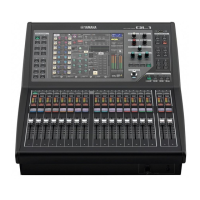QL5/QL1
11 7
C. PHANTOM VOLTAGE (INPUT 1)
With No.2 and No.3 pins of XLR shorted and 10 kΩ load
connected between No.2 and No.1 pins, check that the voltage
is as follows when the +48 key is turned on.
Also, check that discharging starts immediately when the +48
key is turned off.
2-2. QL5: INPUT 17-32
→
OMNI OUT 1-16
QL1: INPUT 9-16
→
OMNI OUT 1-8
Parameters:
QL5: Input the analog signal from INPUT (XLR) of CH 17-32
and measure the signal output from OUTPUT of CH 17-32.
Assign OMNI IN CH 17-32 to OMNI OUT 1-16.
QL1: Input the analog signal from INPUT (XLR) of CH 9-16
and measure the signal output from OUTPUT of CH 9-16.
Assign OMNI IN CH 9-16 to OMNI OUT 1-8.
A. GAIN MIN
1 Gain
2 Distortion
3 Noise level
Parameters: Short the CH IN to be measured with 150 Ω.
4 QL5:
CH17‒32/QL1:CH9‒16
level difference
Confi rm the range of difference in the gain measured in item
1
above as follows.
5 Crosstalk between adjacent channels
Parameters: Turn on OMNI OUT of only one odd number
channel for output, turn off OMNI OUT of other
channels and measure the noise level of even
number channels next to the odd number channel
on both sides.
Short INPUT of the even number channels to be
measured with 150 Ω.
Perform the same check on the even number channels.
Input Frequency
Input Level
Prescribed Output Level Permissible Range
1 kHz +10 dBu +4 dBu +4±2 dBu
Input Frequency
Output Level Permissible Range
1 kHz +22 dBu 0.01 % or below
Permissible Range
–80 dBu or below
5 QL5:
CH1‒16/QL1:CH1‒8
level difference
Confirm the range of difference in the gain measured in
item 1
above as follows.
6 Crosstalk between adjacent channels
Parameters: Turn on OMNI OUT of only one odd number
channel for output, turn off OMNI OUT of other
channels and measure the noise level of even
number channels next to the odd number channel
on both sides.
Short INPUT of the even number channels to be
measured with 150 Ω.
Perform the same check on the even number channels.
7 Maximum output
(QL5: OMNI OUT 1–16 / QL1: OMNI OUT 1–8)
Parameters: Assign only the built-in oscillator to OMNI OUT
1-16 (in case of QL5) or OMNI OUT 1-8 (in case
of QL1).
B. GAIN MIN
1 Gain (QL5: INPUT 1–16 / QL1: INPUT 1–8)
2 Distortion (QL5: INPUT 1–16 / QL1: INPUT 1–8)
3 Noise level EIN (QL5: INPUT 1–16 / QL1: INPUT 1–8)
Parameters: Short the CH IN to be measured with 150 Ω.
If the measured value is out of the above permissible
range,confi rm that “measured value – (Gain at 1kHz)
≦
-128”
is obtained.
4 Level difference (QL5:
CH1‒16/QL1:CH1‒8
)
Confirm the range of difference in the gain measured in
item 1
above as follows.
Input Frequency
Output Level
Permissible Range
Permissible Range(Distortion)
1 kHz +24 dBu +24±0.5 dBu 0.01 % or below
Input Frequency
Input Level
Prescribed Output Level Permissible Range
1 kHz –62 dBu +4 dBu +4±2 dBu
Input Frequency
Output Level Permissible Range
1 kHz +22 dBu 0.02 % or below
Permissible Range
Within 2 dB
Permissible Range
–62 dBu or below
Permissible Range
Within1dB
Permissible Range
Within1dB
Input Frequency
Output Level
(Odd Channel)
Permissible Range
(Even Channel)
1 kHz +23 dBu
‒57dBu or below
Input Frequency
Output Level
(Odd Channel)
Permissible Range
(Even Channel)
1 kHz +23 dBu
‒57dBu or below
Permissible Range
DC 33.6 V — 36.1 V

